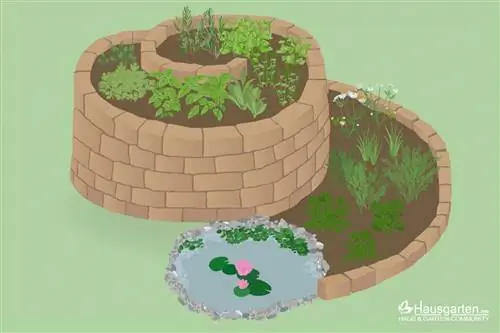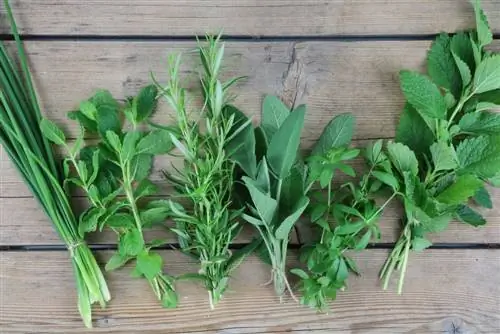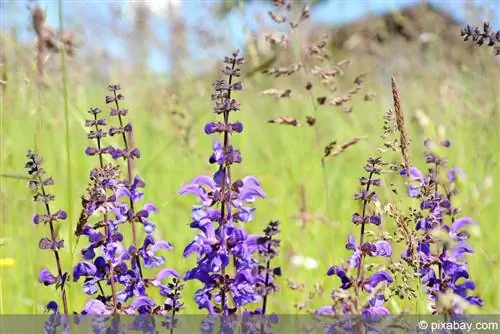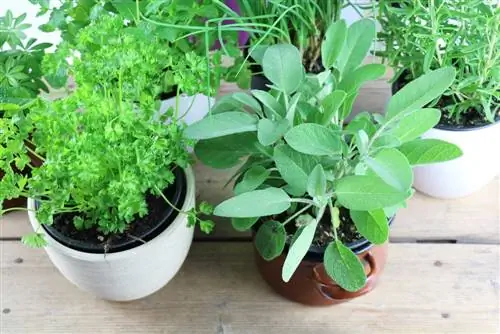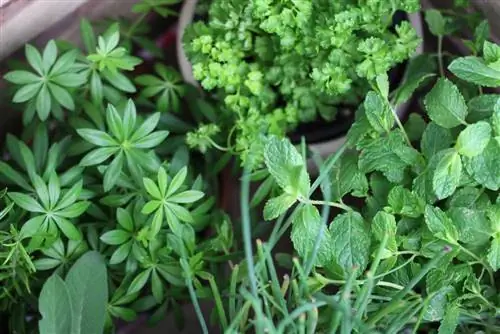- Author admin [email protected].
- Public 2023-12-17 03:39.
- Last modified 2025-01-24 12:45.
Curry herb, also known as Italian strawflower, is a popular herb in the kitchen. The taste is similar to curry spice and can be used in the same way. With its appearance, the curry herb also makes a beautiful decorative plant. In autumn, the silvery leaves form an ingenious combination with flowering perennials on the terrace, balcony and in the garden.
The curry herb usually grows to a height of 50 to 60 cm and blooms from July to August. The small flowers smell like curry spice and are also a wonderfully bright yellow. The curry herb also serves as a decoration when dried and is therefore also called Italian strawflower.
Sowing and propagation of curry herb
The seeds from the curry herb can be bought at the nursery or obtained yourself. To grow it yourself, the existing plant must be flowering. As soon as it has faded, the seeds can be removed. You can also leave the plant with the seed and hope that the seed will disperse automatically. In order for the seed to germinate, it needs a lot of light. It is best to sow the curry herb in spring and use a pot. The seed is pressed very lightly into the soil where it can bond with the soil but still receive enough light. A bright windowsill is completely sufficient for the seeds to germinate. The soil should always be kept moist using a spray bottle. If you were to approach the seed with a watering can, it would be damaged and no longer be able to germinate. That's why you always use a spray bottle for this situation. The first seedling should be visible in the next two weeks.
Planting curry herbs
The curry herb is only partially hardy. You should therefore consider whether sowing seeds in a pot would be more advantageous. If you decide to sow in a pot, just press the seed lightly and leave it in the pot where the curry herb should stay. If you decide to sow seeds in the garden, proceed in the same way and only press the seeds lightly into the soil. If you plant the curry herb in a pot, you can place it on the windowsill and drive away annoying flies and mosquitoes. Also try making a tasty tea from the curry herb - especially in winter, the tea is an easy-to-digest and warming treat.
The Italian strawflower absolutely needs a sunny spot and dry soil to imitate the Mediterranean climate. Only then can the plant grow sufficiently well and enchant the garden with its beauty. In winter the plant should not be left outdoors as it is not hardy in any way. A good place for winter is the windowsill or a heated winter garden.
Caring for the Italian Strawflower
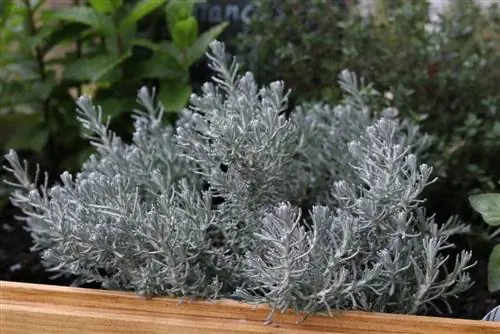
As the name suggests, the Italian strawflower comes from the sunny south. For this reason, you need to make sure that you create a Mediterranean climate as much as possible. Lots of sun and soil that tends to be dry are excellent conditions for the curry herb to grow well. Of course, the plant does not tolerate waterlogging, which explains why you should improve a rather dense and firm soil with sand or expanded clay. If you want to grow several plants in the garden, they will need a space of around 30 cm apart. As soon as the flowering period is over, you can cut the herb back and use it for dry arrangements. If you want to use the curry herb in all its beauty for decorative purposes, you have to cut the curry herb before the flowers open.
Pouring
The Mediterranean climate has little moisture, so the plant's water requirements are very low. Waterlogging must be avoided at all costs as the strawflower would not survive.
Cutting and Harvesting
Since the curry herb is very similar to curry spice, it can be cooked in dishes after harvest. It immediately develops its spicy and aromatic note. However, eating the curry herb is not a good idea as it is difficult to chew and would cause stomach problems. You can harvest the curry herb for cooking whenever you need it. To season dishes, you can cut off individual branches and add them to the food. If you would like to make a dry arrangement of it, it is advantageous if you wait until the flowering period and cut off the curry herb shortly before the flower opens. The Italian strawflower should also be cut back slightly after the flowering period. So that you can enjoy the Italian strawflower for a long time, you should dry it upside down in a protected place.
Wintering
The curry herb is only partially suitable for overwintering. In the sunny south, mild temperatures prevail even in winter. For you, this means that the curry herb can only survive the winter in closed rooms with a mild temperature. When sowing, remember that the strawflower is either sown straight away in a pot or flower box or that you have to take the strawflower out of the garden.
Propagation
The curry herb flowers appear in a dark yellow with spherical heads in pseudo umbels from June to September. During this time, the propagation of curry herb is also particularly successful: by taking cuttings, hobby gardeners can also easily and easily propagate curry herb plants, for example for bed borders as hedge weed or for spreading and decorating with curry herb on balconies and terraces.
What you should know about curry herb in brief
- The curry herb is an excellent alternative to curry spice and can also be used for cooking.
- Care is relatively easy if you give the plant plenty of sun.
- She needs to be brought into the apartment or house for the winter.
- The bright yellowish flowers that appear in summer smell wonderfully of spicy curry and look fantastic.
- As soon as you want to make an arrangement of the curry herb, you will have a colorful arrangement on the table even in winter.
- The curry herb also drives away annoying flies and mosquitoes from the area.
Editor’s Tips

After flowering, the curry bush can be cut back heavily, but only the young leaves and shoots end up in the kitchen. The rest can be used for pretty dry arrangements and bouquets or to create herb-heavy decorations of other kinds (e.g. making wreaths). The curry herb is also suitable for topiary cutting.
The curry herb looks decorative both in pots and in the bed. When planting in the bed, however, it should be noted that this plant originally comes from southern latitudes and is therefore not considered hardy. The planting in the pot should be spent together with the oleander in a cool, not too bright winter quarters. Older plants of this herb are somewhat more durable: well protected by a wall or wrapped in plant protection materials for roses or potted plants that are not hardy, the curry herb, which is several years old, can survive even the temperate winters of our latitudes.
Image source: Otto Wilhelm Thomé: Flora of Germany, Austria and Switzerland. Gera 1885.


